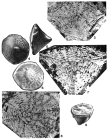Foraminifera taxon details
Ctenorbitoides Brönnimann, 1958 †
722375 (urn:lsid:marinespecies.org:taxname:722375)
accepted
Genus
Ctenorbitoides cardwelli Brönnimann, 1958 † (type by original designation)
marine, brackish, fresh, terrestrial
fossil only
masculine
Brönnimann, P. (1958). New Pseudorbitoididae from the Upper Cretaceous of Cuba, with Remarks on Encrusting Foraminifera. <em>Micropaleontology.</em> 4(2): 165-185., available online at http://www.redciencia.cu/geobiblio/paper/1958_Bronnimann_New%20Pseudorbitoididae.pdf
page(s): p. 171 [details] Available for editors [request]
[request]
page(s): p. 171 [details] Available for editors
Hayward, B.W.; Le Coze, F.; Vachard, D.; Gross, O. (2024). World Foraminifera Database. Ctenorbitoides Brönnimann, 1958 †. Accessed at: https://www.marinespecies.org/foraminifera/aphia.php?p=taxdetails&id=722375 on 2024-04-24
Date
action
by
original description
Brönnimann, P. (1958). New Pseudorbitoididae from the Upper Cretaceous of Cuba, with Remarks on Encrusting Foraminifera. <em>Micropaleontology.</em> 4(2): 165-185., available online at http://www.redciencia.cu/geobiblio/paper/1958_Bronnimann_New%20Pseudorbitoididae.pdf
page(s): p. 171 [details] Available for editors [request]
[request]
basis of record Loeblich, A. R.; Tappan, H. (1987). Foraminiferal Genera and their Classification. Van Nostrand Reinhold Company, New York. 970pp., available online at https://books.google.pt/books?id=n_BqCQAAQBAJ [details] Available for editors [request]
[request]
page(s): p. 171 [details] Available for editors
basis of record Loeblich, A. R.; Tappan, H. (1987). Foraminiferal Genera and their Classification. Van Nostrand Reinhold Company, New York. 970pp., available online at https://books.google.pt/books?id=n_BqCQAAQBAJ [details] Available for editors
From editor or global species database
Diagnosis Test conical, dorsal side flat to slightly umbonate, ventral side conical, with concave flanks and flattened "comblike" apex; centrally placed juvenarium has uniserial, trochospirally coiled chambers with basal apertures, communicating with lateral chambers through fine pores, "equatorial" layer of chambers in this as in other conical orbitoids forms a low cone rather than a plane, pseudorbitoidal structure consists of two systems of alternating vertical plates radiating from the juvenarium to the periphery and separated by a median gap, annular walls present and perforated by radial stolons, vertical plates arise from the nepionic chambers on the ventral side and form a fanlike extension that projects at the cone apex, thick-walled and radially elongate low lateral chambers are separated from the pseudorbitoidal structure by the latter's distinct roofs and floors, flanks and base of the cone covered by eight to nine layers of lateral chambers in regular tiers, pillars among the lateral chambers project as pustules at the surface. U. Cretaceous (U. Campanian or L. Maastrichtian); Cuba. (Loeblich & Tappan, 1987, Foraminiferal Genera and Their Classification) [details]
